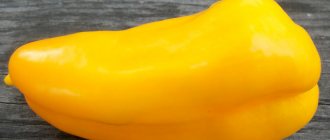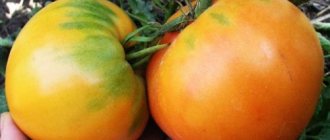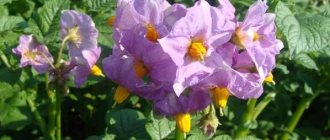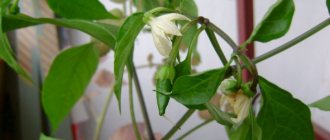Pepper Orange Miracle is a variety of Dutch selection; it is famous among gardeners for its high productive qualities. It has excellent taste characteristics, and the appearance of the fruit makes summer residents surprised and admired.
Pepper Orange Miracle
Pepper seeds Orange miracle
The Orange Miracle pepper bush is tall, but takes up little space in the garden
Origin of the Orange Miracle pepper variety
This hybrid was obtained by crossing other varieties of pepper (there were a large number of them, so it is very difficult to determine the main “parents”). The orange miracle has adopted all the best qualities of other peppers. The birthplace of breeding is Holland.
At the moment, the Orange Miracle pepper variety is considered almost the most popular in Russia. Many gardeners tried to grow it on their plots, and all of them were satisfied with the result.
Not all hybrid pepper varieties are certified and entered into the Russian state register. The Orange Miracle was included in this list in 2012. This proves its importance for gardeners and summer residents not only in Russia, but throughout the world.
Description and characteristics of the variety
The peculiarity of the Orange Miracle pepper is that the fruits are bright orange and the bushes are tall.
Bush
The plant is tall and strong, but despite this, the bush does not take up too much space on the site. When growing pepper in open ground, its height reaches 2 m, and sometimes even higher. The foliage is small in size and deep green in color.
Fruit
Main characteristics of the fruit:
- cube-shaped, slightly drooping;
- large in size;
- weight of one – about 220 g;
- juicy pulp;
- incomplete ripeness - green fruits, full ripening - bright orange;
- excellent sweet taste.
Productivity
The ripening period for Orange Miracle fruits is 105 days, at which time they can already be removed from the plant. An interesting fact is that the fruits picked from the bush ripen at home for another week.
Harvest the crop exactly at the stage of technical maturity, as this contributes to the formation of new ovaries on the bushes. The orange miracle has a high yield - 14-16 kg per 1 sq. m.
Difference from other varieties
The hybrid differs from other varieties of pepper in its large fruits, its walls are very strong and juicy. The pulp is tasty and aromatic. A distinctive feature is resistance to diseases, namely the tobacco mosaic virus. Other varieties of pepper cannot boast of this.
Advantages and disadvantages
- Advantages of the variety:
- possibility of growing in temperate climates;
- large fruit;
- higher wall density than other varieties;
- excellent taste;
- resistance to tobacco mosaic and tomato bronzeness.
The variety has a lot of fans due to its appearance and incredible taste. Manufacturers think brightly colored holiday peppers would be a great way to encourage picky little ones to eat their vegetables.
- Disadvantages of the variety:
- pepper grows and bears fruit better in warm weather;
- requires molding due to the ability for intensive growth;
- requires garter due to the large mass of fruits;
- The variety is a hybrid, and to grow the next year, the seeds must be purchased again.
Agrotechnics of cultivation
Agricultural technology for growing any type of pepper begins with preparing the seeds for sowing. The seed must be disinfected with a weak solution of potassium permanganate; you can also use aloe juice. The procedure is carried out to destroy bacteria in the seeds and increase the immunity of the grains.
After processing, rinse the seeds under running water and you can plant them in prepared containers.
Preparing containers
Grow each sprout of the Orange Miracle pepper in separate pots, otherwise there is a risk of damage to the root system of the plants. Make holes in the containers for better and faster release of excess moisture.
Be sure to place a drainage layer at the bottom of the pots.
Soil preparation
Before planting the grains, fill the pots with light soil consisting of sand (1 part), humus (2 parts) and ordinary soil (1 part).
It is advisable to disinfect the soil first. How to do this correctly - read here.
Water the soil with a small amount of water and plant the planting material to a depth of 3 cm, this will allow the root system to develop normally and quickly. After this, cover the seeds with a small amount of soil and compact them slightly.
In the room with seedlings, maintain a temperature of +25 degrees Celsius. Such conditions will help increase the germination of seed. After germination, lower the temperature to +16 degrees.
Seedling
Seeds for seedlings are sown in the last week of February. There is no need to deepen the grains; the planting pots are covered with film or glass.
Picking
Picking is carried out only if you planted the sprouts in 1 box or large pot. This process involves transplanting the sprouts into separate containers. Picking is carried out after the appearance of 2 true leaves.
Plant the seeds immediately in separate containers so that the root system of the pepper is not damaged during later picking.
Transplantation into open ground
Before transplanting seedlings into open soil, the sprouts are hardened, that is, taken out into fresh air 2 weeks before transplantation. First for an hour, then for 2-3 hours and so on.
Landing
In the autumn season, add organic fertilizers in the form of humus or peat to the soil. Pay special attention to the acidity of the soil; it should not be too low (about 3-4%). Otherwise, you will have to add lime.
Transplant the finished seedlings when they have fully formed 5 leaves, reaching a height of 15 cm. Transplant the plants into the greenhouse according to the 0.5 * 0.5 m pattern. Immediately take care of supports for tying up the plants. Leave approximately 0.6 m in open soil, 0.4 m between depressions. Also prepare supports.
Garter
Rigid supports are necessary for this variety of sweet pepper, as the plants grow tall and need something to rest on.
The Orange Miracle pepper does not need any shaping.
Watering
Watering is the most important point in caring for peppers. It is necessary to regularly monitor soil moisture to prevent rotting of the root system. Add water once every 3 days and do it only in the morning or evening. Otherwise, the water will evaporate too quickly.
Bell pepper Orange miracle, grown in a greenhouse, needs regular spraying of the foliage. Since dry air prevents the plant from fully forming ovaries and fruits.
Mulching and loosening
After abundant watering of the pepper, it is necessary to remove all excess weeds and loosen the soil. Mulch is very important; use peat, straw or sawdust as mulching material.
You can learn everything about mulching the soil from this article.
Top dressing
Fertilization is standard for all varieties of pepper and is carried out 3 times during the growing season:
- During the formation of the first shoots. Add phosphorus microelements that accelerate the growth and development of pepper. Read more about feeding pepper seedlings on the pages of our website.
- During the period of ovary formation. It consists of potassium fertilizers, which help speed up the process of their formation.
- During the fruiting period. Fertilizers consist of calcium and nitrogen, thanks to them the size of the fruit increases significantly and the ripening process accelerates.
Planting and growing peppers
Growers select viable seeds from fully ripened fruit. They are dried and specially treated to protect them from phytopathogens. Such seeds can be planted without pre-planting treatment.
Did you know? The fruits of sweet pepper varieties do not taste the same. Their flavor range
-
from almost tasteless to very sweet.
If you are not sure about the quality of the seeds, you need to process them:
- pour hot water (+50°C) and leave for 30 minutes to destroy the larvae and eggs of pests;
- carry out disinfection against fungi with a solution of potassium permanganate (3%) - exposure time is 12–24 hours;
- growth stimulator increases the percentage of germination and ensures uniform development of plants - the duration of action is indicated on the packaging of the drug (Kornevin, Gibbor-M, Cytodef).
In temperate climates, peppers are grown in seedlings to speed up fruiting. Treated seeds are planted in special containers 8–10 weeks before the last spring frost. Seedlings must be provided with daylight of at least 12 hours, watering regime, fertilization, diving. When the soil warms up to a temperature of +14°C, the Orange Miracle is planted in open ground.
Optimal conditions
Peppers need warm weather to thrive. The optimal temperature for germination is +21…+26°C. Humidity - 70%. Potted seeds do not need light while they are germinating. Germination will take about 14 days. To speed up the process and increase the temperature, containers with seeds are covered with film.
Timing and technology of planting seeds for seedlings
Since seeds are packaged by different companies, the question of choosing them correctly arises. The quality of the bag itself is not equal to the quality of the seeds. Therefore, buy seeds from a company you trust. Also keep in mind that the seed fund is obtained in greenhouses. Therefore, seeds from a company located in the same climate zone as you will be better suited to future growing conditions.
Disinfect seeds from possible phytopathogens using one of the methods described above. Plant seeds 8 to 10 weeks before the last spring frost. This could be February or March, depending on the region.
Did you know? There are more than 1000 types of peppers in the world. India is considered the birthplace of black pepper. And the birthplace of sweets
-
America, where it is still found in the wild.
Soil properties have a significant impact on plant development and yield. For planting, you will need soil with a slightly alkaline reaction: with an acidity level (pH) from 6.2 to 6.8. The mixture should be loose and nutritious.
Possible composition:
- 1/3 good garden soil;
- 1/3 rotted cow manure - it must sit for at least 6 months before use;
- 1/3 sand or perlite to ensure soil looseness.
Planting technology:
- Fill a disposable plastic cup or container with the prepared soil mixture.
- Make a hole in the soil with your finger or the tip of a pencil (2 cm deep).
- Put 2 seeds.
- Cover with soil.
- Moisten with water from a spray bottle.
- Cover with plastic wrap to create the correct temperature.
- Place the seed tray in a warm place.
- Keep the soil moist during the germination period.
Video: planting pepper seeds
Seedling care
Seedling care includes:
- maintaining the necessary microclimate;
- feeding;
- watering;
- dive.
The optimal microclimate for seedlings is warm (+18–20°C) with humidity (about 70%). A sunny windowsill is quite suitable for growing. To prevent seedlings from reaching towards the light source, they are provided with uniform lighting using fluorescent lamps. Watering is done by spraying the soil with a spray bottle approximately once a week. During the growth of seedlings, fertilizing is carried out twice.
Important! The main requirement for a container for seedlings
-
volume.
The roots should not be crowded, otherwise after transplantation they will begin to develop intensively, thereby stopping the growth of the bush itself. The following set of fertilizers is most often used:
- superphosphate - 7.5 g;
- ammonium nitrate - 5 g;
- potassium chloride - 5 g.
The fertilizer mixture is diluted in 2.5 liters of water and watered the root zone.
The timing of the first feeding is determined by the fact that the plants have 2 true leaves. The second feeding is carried out with the same fertilizers 3 weeks after the first. Before applying fertilizing, the soil is moistened. Picking is necessary to improve the development of peripheral roots. To do this, insert a pointed stick into the ground, use it to pry the seedling, take it out, trim the lower part of the main root and plant it in a larger container, where the seedling will grow until planted in the ground.
Important! Seedlings need to be watered in 1
–
1.5 hours before planting in the ground to prevent damage to microroots.
Technology of planting seedlings in a permanent place
A week before planting in the ground, the seedlings are fed with fertilizers and the beds are prepared. The air temperature outside should not be lower than +14°C at night.
Tilling the soil and planting peppers:
- If other plants grew on the site, and there is a suspicion that pests have overwintered in the soil, treat it with boiling water or a 3% solution of potassium permanganate.
- The soil can be covered with black film. This will help warm it up to a temperature of +18°C. This will activate the pests and force them to rise closer to the surface. Then treatment with boiling water will bring better results.
- Dig up the soil so that there are no large clods left - this interferes with the development of roots.
- Dig trenches and add rotted manure to the bottom (1.5 kg per 3 m²).
- Cover it with soil.
- Add water.
- Remove the seedlings from the cups.
- Install them in the trench at a distance of 20 cm from each other.
- Fill the area around them with earth.
- Compact the soil around the trunks by hand.
In open ground
Open ground technology also includes a number of other activities:
- Deep digging - to control pests - is carried out in late autumn in order to lift insects from the ground closer to the freezing zone.
- In spring, measure the acidity level of the soil. If it exceeds pH 7, it is necessary to deoxidize the soil using lime, dolomite flour or chalk.
To the greenhouse
As soon as the winter frosts end, it is time to prepare the greenhouse. First, inspect its integrity and, if necessary, repair it, clean the glass or covering material from dust and dirt for better access to sunlight.
Preparation technology includes:
- Cleaning the beds from organic residues, if any.
- Disinfection with sulfur bombs for several hours.
- Digging the soil.
- Preparation of sites.
- Fertilizer application - compost, humus or manure.
Find out more about how to properly plant peppers in a greenhouse.
Features of growing in a greenhouse
Growing sweet peppers in open ground and in a greenhouse has its own characteristics; let’s consider the main rules for caring for the variety in a greenhouse:
- Regular watering. In the absence of moisture, the variety stops growing. If in open soil the plant can get water thanks to rain, then in a greenhouse it cannot do without your participation. Due to lack of moisture, plants will grow short, and the entire crop will grow small and poorly developed.
- High air humidity. Pepper variety Orange Miracle has a negative attitude towards too dry air in the greenhouse. Spray the plants regularly to prevent the air and soil around them from drying out.
- Fertilizer application . This variety of pepper is very large, so it will not be able to grow full-fledged and strong without fertilizers. Just don’t get carried away with nitrogen fertilizing, otherwise you won’t get anything other than thick foliage.
- Temperature conditions. Maintain a constant temperature. Pepper Orange Miracle grows well at temperatures of +25...+30 degrees Celsius.
This variety of pepper is very sensitive to temperature changes; when it drops to +13 degrees, the plant stops growing and developing altogether.
Take all these rules into account when growing this crop; in regions with a weak and unstable climate, carry out additional mandatory heating.
Parasites and diseases
Aphid
The main parasite that affects this variety of peppers is considered to be aphids. To combat it, you need to use drugs such as Akarin, Fastak or Tanrek.
The solution for spraying is prepared as follows: dilute 1 tablespoon of the drug in 10 liters of warm water. Remember that spraying is carried out only before and after flowering. During fruiting, spraying is prohibited, as this will lead to disruption of the structure of the fruit itself.
Spider mite
You can get rid of a parasite such as spider mites using a solution of onion or garlic. Onions or garlic must be minced and diluted in water. For 1 tablespoon of gruel you need to take 1 liter of water. Such spraying is carried out at any time. Hot ground pepper helps against slugs. It needs to be sprayed over each bush. It is better to do this not in windy weather, so that the drug gets into the infected areas.
Fusarium
If the plant has been exposed to a disease such as fusarium, then you will only have to burn the infected bush. Unfortunately, this fungal disease cannot be cured. It is better to burn the bush away from the garden so as not to infect other crops. It is better not to plant this crop in this place next year, because the bacteria will not have time to disappear.
Peppers Red Bull and Orange Miracle (“Samara seeds”).
Sweet pepper Review of yield at biological maturity Ch5
Shrub pepper Orange miracle
The best varieties of peppers for open ground On my site, August 22
Advantages and disadvantages
The Orange Miracle pepper has its pros and cons, let’s look at them.
Advantages of this variety:
- fast fruit ripening period. The first harvest can be obtained on the 105th day after germination. Under high-quality conditions, the ripening period is reduced to 95 days;
- does not require special care, can be easily grown in any area;
- perfectly tolerates various negative environmental factors, for example, frequent heavy rains;
- pepper has a pleasant and rich taste;
- during storage, the taste of the fruit does not change;
- strong immunity to many types of diseases.
Disadvantages of this variety:
- plants grow chaotically if they are not supported;
- bushes need abundant watering, especially on dry days.
Reviews
★★★★★
Konstantin, 31 years old, Moscow region, architect. I can’t even count how many hybrid varieties of pepper I have grown on my plot.
The last variety was the Orange Miracle pepper, it simply won my heart. It is easy to care for, produces a large amount of harvest, and accordingly met all my expectations. If you provide it with good care, you can get ripe fruits within 3 months. ★★★★★
Vera, 65 years old, Sochi, librarian. My daughter once brought me the Orange Miracle pepper variety to try.
And now I have been growing it for 5 years, as it is simply wonderful. The fruits are thick, tasty, juicy and very bright. I harvest a lot, and I don’t spend much time caring for it. I will grow the Orange miracle until I get tired of it, and I am sure that this will not be soon. Hide
Add your review
The Orange Miracle pepper variety is excellent for growing not only in open ground, but also in a greenhouse. It has practically no disadvantages, but has a lot of advantages: excellent taste, beautiful appearance, relatively early ripening, strong immunity.
0
0
Copy link
Denis
Quite early ripening and popular among amateurs. From germination to harvest it takes only 80-95 days. Most often used for planting in open ground. The peppercorns are bright red, large and dense, the weight of some specimens reaches 400-500 grams.
Denis is especially resistant to diseases such as tobacco mosaic. Due to its large dimensions, it is rarely used for preservation; it is usually consumed fresh or in the preparation of various dishes.
ATTENTION! Denis is very sensitive to lack of moisture, does not tolerate hot sun rays, and on especially hot days the plant needs to be covered.











